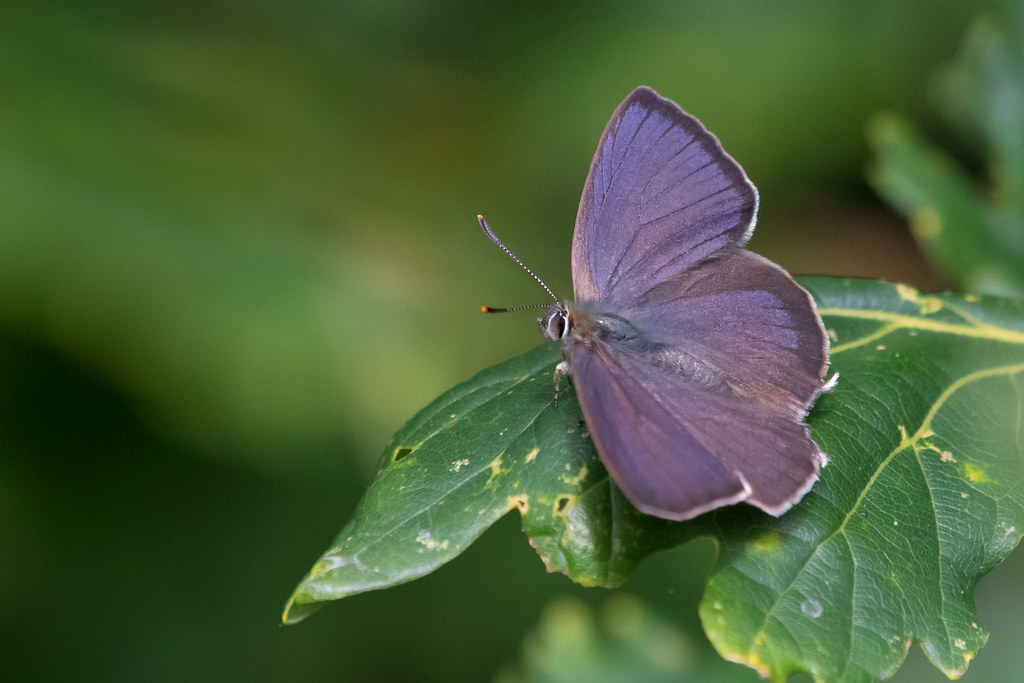
Tim writes: Purple Hairstreaks are one of our commonest hairstreaks, but they are not easy to see and even less easy to photograph. That’s because they are essentially a treetop butterfly that only occasionally ventures down to ground level. They occasionally visit flowers but usually obtain their sugary fuel from aphid honeydew on tree leaves. Another habit that makes them difficult to see is that they are most active in the evenings, and on sunny mornings, often sitting motionless during the day. And one final annoying habit they have, is being rather shy of opening up their wings to flash their purple. They usually keep their wings clamped tight, which makes any open-winged shot a real prize. I arrived at a local oak wood at 7am on 24 July and the Purple Hairstreaks were already flying in the morning sunshine. I saw a number of them, both flying and perched very high in the oak trees. But after about an hour two of them descended to eye level and allowed me to take a few photographs. This was in a sunny glade of oak trees not far from Penistone in South Yorkshire.
This is a male with an even purple sheen across all four wings. Females have a much more intense iridescent purple around the base of the forewings, that reminds me of a Cadbury’s Milk Chocolate foil wrapper. The rest of the female’s wings are blackish. I have posted one in the comments below for comparison.
The scientific generic name has changed about four or five times since I first learnt its scientific name about 45 years ago; Thecla, Quercusia, Zephyrus, Neozephyrus and currently Favonius. Thankfully its specific name quercus has remained unchanged since Linnaeus first named it in 1758. The name “quercus” was given to reflect this butterfly’s foodplant Oaks (Quercus robur and Q. petraea). The current generic name Favonius was first given to an Eastern Palaearctic hairstreak Favonius orientalis. Favonius means pertaining to the west wind, and the adjective favonian means mild, referring to weather when the wind is in the west. A previous generic name Zephyrus is also a Greek name for the west wind.
[registration_form]
I didn’t have much luck photographing Purple Hairstreaks this year through a combination of weather and the numbers not being so high on my local sites (my experience being you have good and bad years for their populations). Also, I don’t know if it’s just my local population but I’ve never had any luck getting any with the full purple inner wings, just smaller patches.
However, the population on Butterfly Conservation’s Prees Heath Common in North Shropshire has given me a unique chance to observe them, because the Oaks they are in a not that tall and their canopies come right down to the ground. Most in other places have just given me neck ache peering up into the canopy.
I’ve observed some very strange behaviour and I have got photographs of it on my Flickr Photostream. This is 2-3 individuals “wrestling” and trying to push each other off a leaf. It’s a bit like Lepidopteran sumo wrestling. At first when I saw it I thought they were tasting each other with their mouthparts. But no, they are using their mouthparts as a sort of battering ram as they try to push each other off the leaves. I’ve asked various butterfly experts about this behaviour and none of them seem to know anything about it. One series of photos I’ve got, show two Purple Hairstreaks pushing another one off a leaf.
I assume these are males vying for a prime spot as this always takes place on Oak leaves in the most sheltered and sunny spots.
Interesting observation. My experience with the purple hairstreak is mainly of the craned-neck staring up at the tree-top kind with occasional sightings of individuals nectaring at ground level but descriptions of male-male contests in the literature seem to be confined to the aerial chases that can be seen from ground level. Newland describes some canopy-level observations of the species in British Wildlife 2009 (pp 317 – 320) and he does not mention the behaviour you describe between males. The only face-to-face encounters he refers to are matings where he describes a ‘perfunctory face-to-face contact of antennae lasting about ten seconds’ immediately prior to copulation.
Your observations are interesting and I am sure would be worth publishing as this is a species whose lifestyle means that it is little observed and is very likely not fully described.
I hope Mark doesn’t mind me leaving the link to the images on my Flickr Photostream, and you will see a comment by Tim about one. For what it’s worth I agree with Tim that it is probably 2 males vying for a prime spot.
https://flic.kr/p/K8XDWT
This one is of 2 Purple Hairstreaks pushing another off a leaf.
https://flic.kr/p/27GrS3h
It should be noted that each of these are just one of a series of images taken over a minute or so. This illustrates that it wasn’t just brief contact, but continued pushing and wrestling. The first and last photos of the pair were 1 minute 3 secs, from start to end, and the group of 39 seconds to first and last photos. Bearing in mind that this had been going on for a bit before I started taking photos. It was also quite early in the morning, 6:30am or so. But it was in that very hot summer of 2018, and it was already quite hot by then.
Great photos SteB. Just to be clear I was not suggesting that what Newland describes is what you saw. I agree with you that your photos appear to show some kind of territorial struggle taking place. The second photo with the two females bulldozing the male is amazing. As I said, it would be of interest to publish these observations.